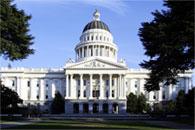New California bills raise bar for renewable energy
 A new energy bill, the Clean Energy and Pollution Reduction Act – SB [Senate Bill] 350 – passed the California legislature on in September by a wide margin: 52-26. Governor Jerry Brown is expected to sign the measure. The legislation raises the renewable portfolio standard (RPS) in the state for the first time since 2005. It originally contained three provisions, mandating three energy goals to be achieved in California by 2030. These are a 50 percent target for renewable energy out of all energy sources, a 50 percent increase in energy efficiency for existing buildings, and a 50 percent cut in petroleum use.
A new energy bill, the Clean Energy and Pollution Reduction Act – SB [Senate Bill] 350 – passed the California legislature on in September by a wide margin: 52-26. Governor Jerry Brown is expected to sign the measure. The legislation raises the renewable portfolio standard (RPS) in the state for the first time since 2005. It originally contained three provisions, mandating three energy goals to be achieved in California by 2030. These are a 50 percent target for renewable energy out of all energy sources, a 50 percent increase in energy efficiency for existing buildings, and a 50 percent cut in petroleum use.
The law reflects the public’s desire for increased clean energy use. Even a poll conducted by fossil fuel backed California Business Roundtable, found that 78% of respondents support the renewable energy goals of the bill, 70% support reducing petroleum use by half, and 74% support doubling energy efficiency.
Not surprisingly, the provision that petroleum use in the state must be reduced 50 percent in fifteen years provoked the fierce opposition of (and a high-powered media campaign by) the oil industry. In the end, objections to this particular provision by moderate Democrats in the state legislature doomed it, and it was removed before the bill was submitted for a vote. The other two provisions easily passed. California’s utilities did not oppose the bill.
Many energy professionals see the most important purpose of the law is to encourage the continued growth of renewable energy. In this article, Steve Chadima, a director of the industry group Advanced Energy Economy, is quoted as saying: “The most important thing the businesses need is a market signal… Continue hiring. Continue growing.” Installers are quite happy with the law because it creates a positive business environment for solar power.
Prior to its passage, growth of large-scale solar projects by utilities had slowed in the state because the utilities were on track to hit the earlier (2005) renewable energy target. This target set a goal of one-third of all the state’s energy coming from renewable sources by the year 2020. Bernadette Del Chiaro of the California Solar Energy Industries Association (CALSEIA) is quoted as saying, “The wheels [now] start turning again” for new, large-scale solar projects. “We want [solar] to be as commonplace as a cellphone,” she added.
Although solar advocates applauded the bill, organizations like SEIA noted that they were not resting, but focusing on implementing the law and on obtaining a favorable ruling by the state’s Public Utilities Commission in its upcoming decision on net metering.
In the attention given to the “big picture” legislation, somewhat lost is another important bill that may alter the relationship of low-income communities, particularly communities of color, to solar power. AB [Assembly Bill] 693 would create the “Multifamily Affordable Housing Renewable Energy Program.” In California, there are approximately 5 million low-income ratepayers, many of whom live in rental housing. The goal of the legislation is to install 300 megawatts of rooftop solar on multifamily affordable housing projects through 2030. The renters in these projects would receive part of the energy produced on the roof of their apartment complexes, reducing their monthly utility bills. The bill would direct $100 million in funds per year over ten years (one billion dollars in total) to pay for solar systems on qualified low-income rental properties. AB 693 will also generate new local clean energy jobs in these communities.
Strela Cervas, Co-Director of California Environmental Justice Alliance (CEJA), was quoted as saying, “While low-income communities and communities of color have long been locked out of the economic and environmental benefits of renewable energy, AB 693 will bridge this green divide. It will infuse low-income communities with health and economic benefits by lowering utility bills and creating clean energy in some of the communities that have been most impacted by pollution.”
With these two bills, California continues its role as a pioneer in the dissemination of renewable energy, particularly solar, and more and more Californians are being impacted by its policies.
